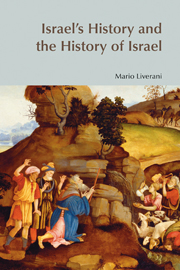Book contents
- Frontmatter
- Dedication
- Contents
- List of Tables and Illustrations
- Foreword
- Abbreviations
- IMPRINTING
- Part I A NORMAL HISTORY
- INTERMEZZO
- Part II AN INVENTED HISTORY
- Chapter 13 RETURNEES AND ‘REMAINEES’: THE INVENTION OF THE PATRIARCHS
- Chapter 14 RETURNEES AND ALIENS: THE INVENTION OF THE CONQUEST
- Chapter 15 A NATION WITHOUT A KING: THE INVENTION OF THE JUDGES
- Chapter 16 THE ROYAL OPTION: THE INVENTION OF THE UNITED MONARCHY
- Chapter 17 THE PRIESTLY OPTION: THE INVENTION OF THE SOLOMONIC TEMPLE
- Chapter 18 SELF-IDENTIFICATION: THE INVENTION OF THE LAW
- EPILOGUE
- Bibliography
- Index of References
- Index of Names of Persons and Deities
- Index of Placenames
Chapter 14 - RETURNEES AND ALIENS: THE INVENTION OF THE CONQUEST
from Part II - AN INVENTED HISTORY
- Frontmatter
- Dedication
- Contents
- List of Tables and Illustrations
- Foreword
- Abbreviations
- IMPRINTING
- Part I A NORMAL HISTORY
- INTERMEZZO
- Part II AN INVENTED HISTORY
- Chapter 13 RETURNEES AND ‘REMAINEES’: THE INVENTION OF THE PATRIARCHS
- Chapter 14 RETURNEES AND ALIENS: THE INVENTION OF THE CONQUEST
- Chapter 15 A NATION WITHOUT A KING: THE INVENTION OF THE JUDGES
- Chapter 16 THE ROYAL OPTION: THE INVENTION OF THE UNITED MONARCHY
- Chapter 17 THE PRIESTLY OPTION: THE INVENTION OF THE SOLOMONIC TEMPLE
- Chapter 18 SELF-IDENTIFICATION: THE INVENTION OF THE LAW
- EPILOGUE
- Bibliography
- Index of References
- Index of Names of Persons and Deities
- Index of Placenames
Summary
The Phases of the Return
The ‘oaths’ or ‘promises’ of Yahweh to Abraham and then Moses correspond, at the mythical level, to the legal function of the edicts of the Persian emperors: they provide legitimation for the return and bestow entitlement of property to the land. But at the practical level, the actual return of exiles and their takeover of Palestine required another model. The patriarchal traditions could be used by the returnees as a prefiguration of their presence in the country; but the remainees could equally appeal to them as a model of coexistence between complementary groups. These stories offered the returnees a ‘weak’ yet realistic model of return: in small groups, without direct conflict, by agreement with the residents and surrounding peoples, sharing the land and its resources. The traditions of the conquest offer a ‘strong’ model, preferred by the supporters of violent confrontation and of the exclusion of ‘extraneous’ people. These were logically (or at least narratively) connected to the ‘exit from Egypt’ that marked the liberation of the people from slavery in a foreign land.
But did an actual return take place along these ‘strong’ lines? Though there are doubts about the historical reliability of Ezra and Nehemiah (written a couple of centuries after the events they describe and betraying a strong ideological influence), it is clear that the return did not happen all at once and did not involve any particularly violent military conflict.
- Type
- Chapter
- Information
- Israel's History and the History of Israel , pp. 270 - 291Publisher: Acumen PublishingPrint publication year: 2005



